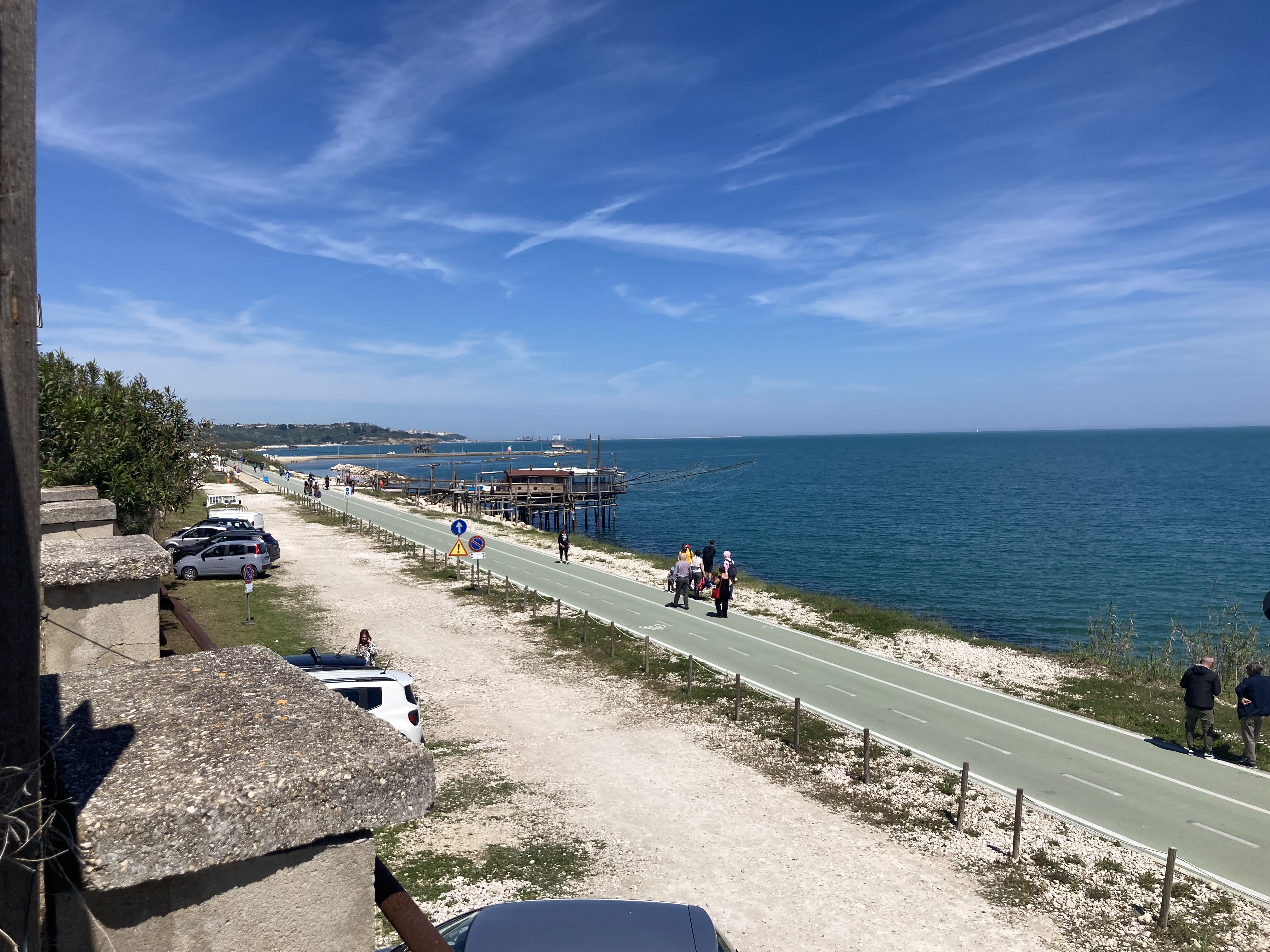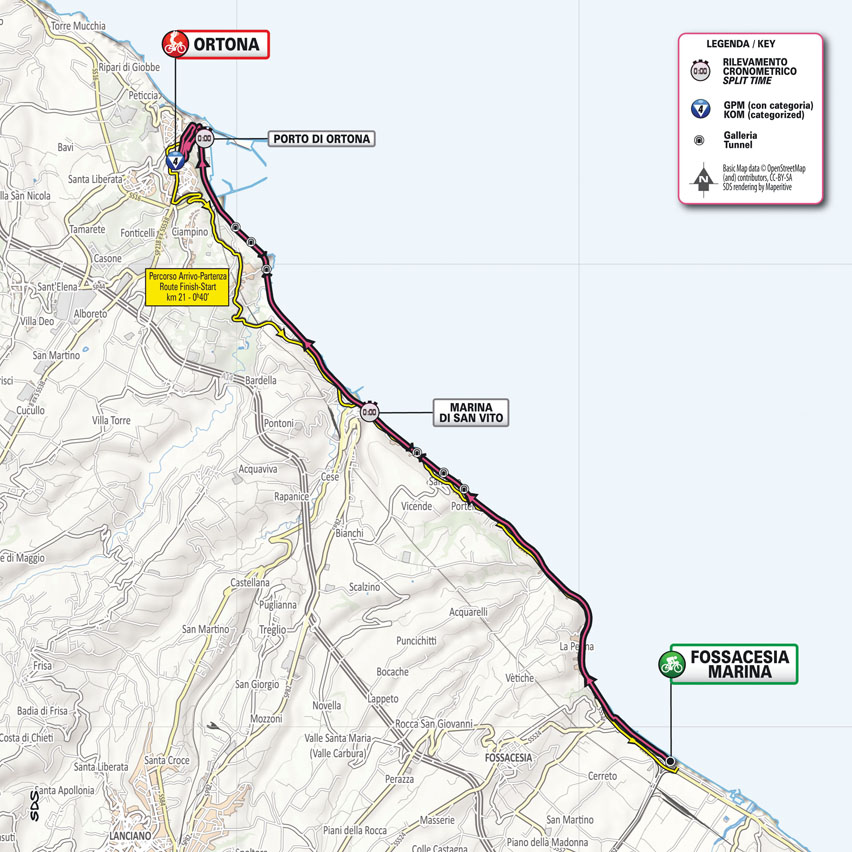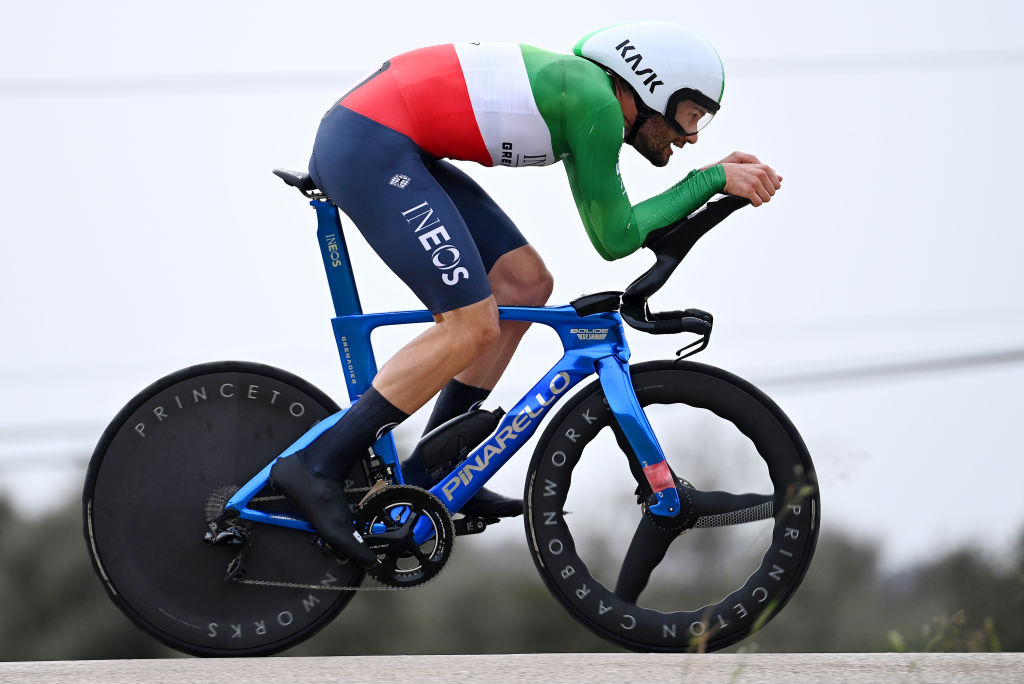
If you had to name the most striking feature of the opening time trial of the 2023 Giro d’Italia, it wouldn’t be the fact that most of it isn’t on a normal road or that most (but not all) is almost ridiculously flat. The biggest takeaway is its length.
Location: Fossacesia Marina to Ortona
Date: May 6, 2023
Time: 13:50-17:10 CET - full start times
Distance: 19.6km (ITT)
At 19.6 kilometres, no opening individual time trial in the Giro d’Italia has ever gone such a distance before. As Primož Roglič put it simply in his pre-race press conference: "It’s a GC day."
And given its length, as far as Grand Tour time trials are concerned, it's also a historic one.
How much of a GC day Saturday afternoon’s power ride up the Adriatic coastline will prove to be in the final reckoning of a Giro which tackles Alpine colossi like the Bondone and San Bernardo - not to mention a far harder uphill time trial on the last day - is hard to predict.
But in a Giro with 70 kilometres of individual time trialling - the most of any Giro since 2013 and three times as much as in 2022 - Saturday is a big opportunity for the specialists against the clock to put some distance between themselves and the mountain racers. To put it in a nutshell, this time trial matters.
The most recent similar length individual opening time trial of any Grand Tour was in the Giro in 2020: 15.1 kilometres in Palermo, when Filippo Ganna won by 22 seconds over João Almeida and 23 over his Ineos Grenadiers teammate Geraint Thomas. Although all three riders are racing the Giro again this year, and will surely be up there in the TT rankings on Saturday, it’s worth bearing in mind the Sicily time trial was mostly downhill and was on a ‘normal’ road.
The course in detail

In contrast, Saturday’s course is mostly resoundingly flat and smooth, and all bar the last three kilometres - which contain a very short fourth category climb - are held on a bike path.
Running along a disused railway line, the time trial is just a small segment of a much larger network of coastal bike paths, known in its totality as the Ciclovia Adriatica and, in this particular section in the Abruzzo region, the Ciclovia Costa dei Trabocchi.
The start of Saturday’s TT, close to a marina docking area on the Adriatic coast, is not the most spectacular, situated on the windswept edge of an area of scrubland and bushes. After just a few hundred metres, the course moves onto the bike path, and there it stays for the next 15 kilometres, with none of the turn-offs, sharp corners or other variants that usually feature in a TT.
As you'd expect from a former railway trackway, the bike path itself is a seamless ribbon of khaki green tarmac, the width of perhaps a car and a half and running on a gradient that barely changes. For the record, the course starts at two metres above sea level, reaches 14 metres above sea level after eight kilometres and then drops back to six at Porto di Ortona, by the time it reaches the foot of the climb that concludes the course.
The one thing that does change is the backdrop to the bike path, but only up to a point. For much of the course, the path cuts a clean, straight line through a dense semi-rural jumble of low-lying homes and gardens, beach bars and restaurants, small fields and painfully narrow twisting access roads, all of these coming off a weatherbeaten B road that runs roughly parallel to the coast.

Curiously enough, the more built-up areas of high-rise apartments and hotels that clog up so much of the Italian seashore don't feature at all in this part of the Adriatic coastline. But in any case, to the right, there’s always the sea, sometimes a couple of hundred metres away from the bike path and sometimes so close if a rider doesn't pay attention or gets caught by a gust of wind, he could almost end up veering into it.
The coastline gets notably hillier as the route heads northwards, and the snow-peaked Apennines are visible some 50 kilometres further inland. But the railway-turned-bike path simply bores through any of the craggy headlands in its path, with six tunnels featuring on the time trial course. The longest tunnel measures 520 metres and comes just after the first intermediate checkpoint at kilometre 8, when the course rolls past the platform of the old railway station of Marina di San Vito.
Bike paths running along disused railway lines have been used before in Giro opening time trials; in 2015, the race started with an 18-kilometre TTT on the Riviera dei Fiori cycle path, built on a former coastal rail track between San Lorenzo al Mare and Sanremo. The big difference is that this opening test is an individual one, not a collective one, so there's no hiding poor form in the midst of a cloud of teammates.
As for the climbers amongst the Giro's GC contenders, Jack Haig (Bahrain Victorious) recognised on Friday a 19.6-kilometre solo TT like this one is "not ideal for me" or his teammates.
“We reconned the course on Thursday, and I hope that the wind changes. I hear there could be a pretty strong headwind which can make the time trial tough on a bike path course like that. It's a good course for specialists like Ganna, who can hold the most aerodynamic positions. Hopefully, there won’t be any problems."

The sting in the tail to the resoundingly flat first 80% of the course comes when it moves off the bike path in Porto di Ortono. It then runs for about half a kilometre on flat roads between a small dock and the new railway station before swinging sharply left onto the final climb. But it’s not a hugely difficult ascent, rising with an average gradient of five percent on broad, well-surfaced roads for roughly a kilometre.
There are a couple of switchbacks, one rising to about 9% - the steepest ramp of the ascent - but they are not excessively difficult. Certainly, none of the riders seen out training on Friday morning shifted their position off their time trial bikes to go around them, and most were still in the big ring. There’s even a couple of hundred metres of flat halfway up for riders to catch their breath before the final, grinding ascent up to the first summit.
The trickiest part of the finale comes when the riders reach that first high point of the climb and abruptly swing right through the hilltop town of Ortono, instantly moving onto a fast, narrow downhill section between buildings, with a couple of technical corners right at the end. It's a sudden change of pace, and there's more to come. After one final, very sharp, left-hand bend, the road then rears up again slightly, running back into the town centre on a narrow paved road and under the finishing gantry at last.
The final climb is obviously a challenge at the end of such a long course. But Alexandr Vlasov (Bora-Hansgrohe) brushed off suggestions that riders will have to calculate their strength accordingly.
"It’s almost all flat, and in the final part, it’s full gas uphill or even flat in places," the former Giro top-5 finisher said. "It’s not complicated to go up at a fast pace."
Million-dollar question

As for the weather, it’ll likely be warm, reaching temperatures of 24 degrees mid-afternoon, and given its coastal location, humidity could hardly be low. But neither will be excessively hard to handle.
Perhaps more importantly, it's not forecast to be windy. So although the course is very exposed, and teams with more than one GC racer will probably try and put them at different times in case there is a sudden change in the weather, it's not likely to prove a decisive issue.
The million-dollar question is who will be in pink on Saturday afternoon, with the most obvious candidates amongst the specialists' Ganna and Stefan Küng (Groupama-FDJ).
But the length of the TT is such that on the GC front, Saturday also represents a chance for Remco Evenepoel, say, to repeat his 2022 Vuelta time trial victory, taken on an almost equally flat course in Alicante. That said, Roglič’s time trial track record in Grand Tours is variable, but it's hardly a poor one, and Almeida, Geraint Thomas and Jay Vine (UAE Team Emirates) could make their own challenges as well.
One thing is clear: on a course this long, we’ll know a lot more about each GC rider’s current form than we would after a normal prologue.
Subscribe to Cyclingnews for our best Giro d'Italia coverage







